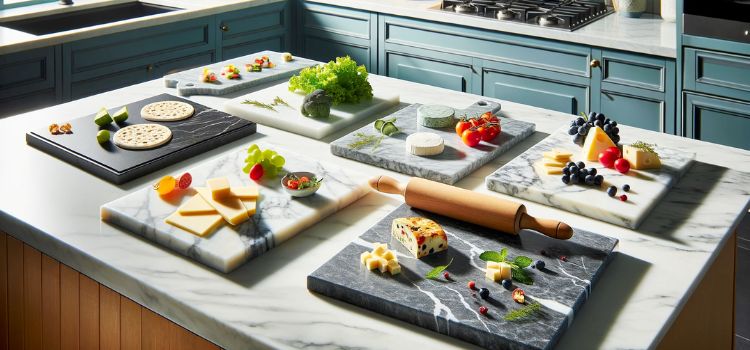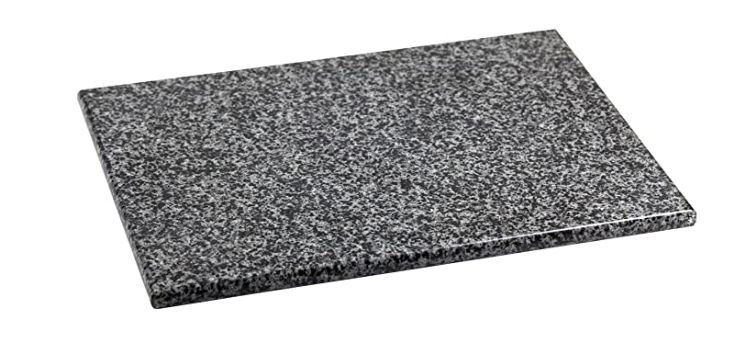As an Amazon Associate, I earn from qualifying purchases

When it comes to cutting board materials, variety abounds. From classic oak and versatile plastic to bamboo and even glass, each offers distinct advantages. Stone cutting boards, however, bring a different set of qualities to the table. Known for their durability and striking appearance, these boards have captured the interest of many home chefs who want both function and form.
Stone Cutting Boards Defined
Unlike other materials, stone cutting boards are crafted from natural stones such as granite, marble, or slate. This gives them a hard and cold surface, making them a unique choice for those who want something different from the usual wood or plastic. Their natural stone composition not only provides durability but also a visual appeal that can complement various kitchen styles.
Benefits of Stone Cutting Boards
Exceptional Durability and Resistance to Scratches
One of the main draws of stone cutting boards is their durability. Stone is inherently tough and resistant to scratches and dents that often mar the surfaces of wood and plastic boards. This makes stone an excellent choice for heavy-duty chopping tasks and for those who want a board that will maintain its appearance over time.
Aesthetic Appeal and Variety in Design
Stone boards are not just functional; they’re also beautiful. Available in a range of designs and colors, from the speckled elegance of granite to the sleek sophistication of marble, these boards can serve as a stunning centerpiece on your countertop. Their aesthetic appeal makes them a popular choice for serving as well, doubling as elegant cheese platters or sushi trays.
Heat Resistance and Versatility
Another benefit of stone cutting boards is their heat resistance. Unlike wood or plastic, stone can withstand high temperatures, making them suitable not only for chopping but also for tasks like rolling out dough or even serving hot dishes directly from the oven. This versatility adds a practical dimension to their beauty.
Potential Drawbacks of Stone Cutting Boards
- Impact on Knife Sharpness: The hardness of stone, while great for durability, poses a significant downside: it can dull knives faster than wood or plastic boards. Chefs who value their knives’ sharpness may find this a major concern. Regularly honing and sharpening knives becomes essential when using stone boards, adding to maintenance efforts.
- Heaviness and Risk of Injury: Stone cutting boards are considerably heavier than their counterparts, which can make them cumbersome to move and handle. This heaviness also increases the risk of injury if a board is accidentally dropped, potentially causing damage to floors or, worse, feet. Therefore, they may not be ideal for kitchens where boards need to be frequently moved.
- Maintenance Requirements and Risk of Chipping: While stone is durable, it isn’t immune to chipping, especially at the edges. Care must be taken to avoid dropping or striking the board with heavy objects. Unlike wood, which can be sanded down to repair surface damage, chipped stone may require professional repair or replacement.
Comparison with Other Cutting Board Types

- Wood Cutting Boards: Wood cutting boards, renowned for their knife-friendliness, differ significantly from stone. While wood boards are gentle on knives, they require regular maintenance like oiling to prevent cracking. Stone boards, on the other hand, need minimal upkeep, but their hardness can be tough on knife edges. Thus, they present a trade-off between convenience and knife care.
- Plastic Cutting Boards: Plastic boards are popular for their affordability and ease of cleaning, often being dishwasher safe. However, they lack the durability and aesthetic charm of stone. While plastic boards are practical for quick tasks, they may not provide the longevity or visual appeal that stone offers.
- Glass Cutting Boards: Glass boards share some similarities with stone in terms of durability, but they differ in practicality. Glass is often criticized for being too slick and for dulling knives more quickly. Stone offers a more stable surface for cutting, though it shares the drawback of being hard on knife blades.
Conclusion
Stone cutting boards bring a unique blend of durability, aesthetic appeal, and versatility to the kitchen. They are particularly suitable for those who value a board that can double as a serving platter or who need a surface that can withstand heat. However, the potential for dulling knives and the board’s weight require consideration.
Ultimately, whether a stone cutting board is a good choice depends on your cooking style and priorities. If you prioritize aesthetics and durability, and are willing to maintain your knives accordingly, stone might be the perfect fit. Conversely, if knife sharpness is paramount, you might opt for a more forgiving surface. In balancing these factors, stone cutting boards can indeed be a valuable addition to many kitchens.
FAQ
Are stone cutting boards better than wood?
Stone cutting boards offer exceptional durability and aesthetic appeal but are harsher on knives compared to wood. Wood boards are gentler on blades and self-healing, but require regular maintenance. The choice between them depends largely on personal priorities regarding knife care and board appearance.
Is stone good for chopping board?
Stone serves as a robust chopping board due to its durability and resistance to scratches. It’s ideal for tasks requiring a hard surface. However, its hardness can dull knives more quickly than wood or plastic, making frequent sharpening necessary to maintain blade effectiveness.
Are stone cutting boards sanitary?
Stone cutting boards are non-porous, reducing the risk of harboring bacteria and making them easy to clean. Unlike wood, they don’t absorb juices or odors. However, proper sanitation practices, such as regular cleaning and drying, are essential to maintain their hygienic properties.
As an Amazon Associate, I earn from qualifying purchases